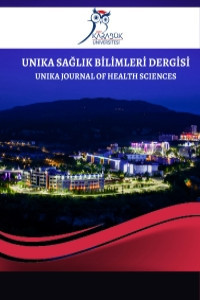COVID-19 Döneminde WEB Tabanlı Eğitim: Kesici Delici Alet Yaralanmalarına Yönelik Verilen Eğitimin Etkisi
Amaç: Bu çalışmada, COVID-19 döneminde öğrencilere verilen WEB tabanlı kesici delici alet yaralanmalarına yönelik eğitimin etkisinin incelenmesi amaçlandı. Gereç ve Yöntem: Yarı deneysel tasarımda olan bu araştırmanın örneklemini, araştırmaya katılmayı kabul eden 513 öğrenci oluşturdu. Veri toplama aracı olarak, araştırmacılar tarafından literatür doğrultusunda geliştirilen, sosyodemografik özellikleri sorgulayan “Tanıtıcı Bilgi Formu” ve kesici delici alet yaralanması hakkında bilgi düzeylerini değerlendiren form kullanıldı. Eğitim öncesi “Ön Test” uygulandı ardından WEB tabanlı eğitim sistemi üzerinden 40 dakika süren “COVID-19 ve Kesici Delici Alet Yaralanması” eğitimi gerçekleştirildi. Eğitim sonrasında “Son Test” uygulandı. Bulgular: Araştırmaya katılan öğrencilerin yaş ortalaması 20,63±2,08 yıl ve %75,4’ü kadındır. Katılımcıların %66,7’sinin hemşirelik öğrencisi olduğu, %42,7’sinin birinci sınıfta öğrenim gördüğü ve %92’sinin herhangi bir sağlık kuruluşunda çalışmadığı ve %94,3’ünün bu eğitimi gerekli bulduğu belirlendi. COVID-19 döneminde öğrencilere verilen WEB tabanlı kesici delici alet yaralanmalarına yönelik bilgilerinin sorgulanan ve araştırmacılar tarafından literatür doğrultusunda hazırlanan sorulara verilen eğitim öncesi ve sonrasındaki cevaplar istatiksel olarak anlamlı bulundu. Sonuç: Bu araştırmaya göre; kesici-delici alet yaralanmalarına yönelik yapılan eğitimin etkili olduğu belirlenmiştir. Eğitim etkinliğinin daha net bir çerçeveden belirlenmesi için öğrencilerin klinik ortamda gözlenmeleri ve prospektif çalışmaların yapılarak kesici delici alet yaralanmaları insidanslarının saptanması önerilmektedir.
Anahtar Kelimeler:
COVID-19, Kesici delici alet yaralanmaları, Öğrenci, WEB tabanlı eğitim
WEB-Based Education in the Time of COVID-19: The Impact of Education on Sharps Injuries
Objective: In this study, it was aimed to examine the effect of the WEB-based stab wounds of the students during the COVID-19 period. Methods: The sample of this research, which is in quasi-experimental design, consisted of 513 students who agreed to participate in the research. As a data collection tool, the "Descriptive Information Form" developed by the researchers in line with the literature, questioning sociodemographic characteristics, and the form evaluating the knowledge levels about sharps injuries were used. “Pre-Test” was applied before the training, and then the “COVID-19 and Sharps Injury” training, which lasted 40 minutes, was carried out over the WEB-based training system. After the training, “Final Test” was applied. Results: The mean age of the students participating in the study was 20.63±2.08 years and 75.4% of them were women. It was determined that 66.7% of the participants were nursing students, 42.7% were studying in the first year, 92% were not working in any health institution, and 94.3% found this training necessary. The answers given to the questions prepared in line with the literature by the researchers, who were questioned about WEB-based sharp and stab wounds given to the students during the COVID-19 period, were found statistically significant. Conclusions: According to this research, It has been determined that the training for sharps injuries is effective. To determine the educational effectiveness from a clearer framework, it is recommended to observe the students in the clinical setting and to determine the incidence of sharps injuries by conducting prospective studies.
Keywords:
COVID-19, Sharps injuries, Student, WEB based education,
- Başlangıç: 2021
- Yayıncı: Karabük Üniversitesi
Sayıdaki Diğer Makaleler
Pandemi Sürecinde Emzirmenin Önemi
Nükte TAŞLAR, Reyhan AYDIN DOĞAN, Selma HANCIOĞLU AYTAÇ
Hücresel Tarım ve Hücre Bazlı Gıdaların Kullanımı
Hüseyin Avni KIRMACI, Emre AKMANOĞLU
Hatice ERDOĞAN, Gizem KUBAT BAKIR, Zeynep AKÖZLÜ, Doğa ULCAY, Sena Melike TAŞCI
Ebe ve Hemşirelerin Doğum Şekli Tercihi ve İlişkili Faktörler: Hastane Tabanlı Kesitsel Çalışma
Dilek TÜRKMEN KURTOĞLU, Sibel MUTLU, Engin YURTÇU, Raziye ÖZDEMİR
COVID-19 Kliniklerinde Çalışan Sağlık Çalışanlarının Depresif Belirtilerinin Değerlendirilmesi
Muhtedir CANER, Yeliz TAŞDELEN, Seydi Ali PEKER, Belkıs SÜRÜCÜ, Kübra KEŞEF, Nihal KARGIN
Ergenlerde Benlik Algısı ve Sosyal Medya Tutumu Arasındaki İlişkinin İncelenmesi
